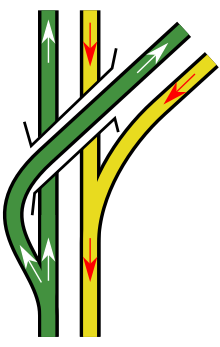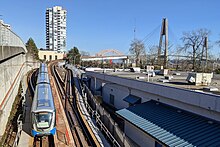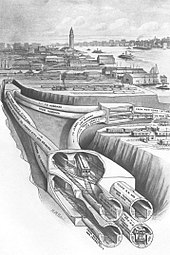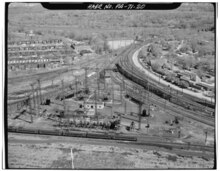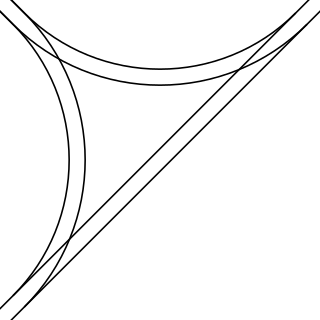
In railroad structures, and rail terminology, a wye or triangular junction is a triangular joining arrangement of three rail lines with a railroad switch at each corner connecting to the incoming lines. A turning wye is a specific case.

An overpass, called an overbridge or flyover in the United Kingdom and some other Commonwealth countries, is a bridge, road, railway or similar structure that is over another road or railway. An overpass and underpass together form a grade separation. Stack interchanges are made up of several overpasses.
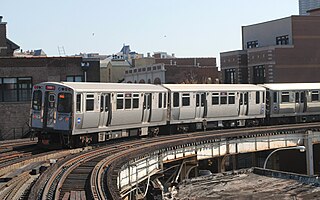
The Red Line is a rapid transit line in Chicago, run by the Chicago Transit Authority (CTA) as part of the Chicago "L" system. It is the busiest line on the "L" system, with an average of 93,457 passengers boarding each weekday in 2022. The route is 26 miles (42 km) long with a total of 33 stations. It runs elevated from the Howard station in the Rogers Park neighborhood on the North Side, through a subway on the Near North Side, Downtown, and the South Loop, and then through the Dan Ryan Expressway median to 95th/Dan Ryan in the Roseland neighborhood on the South Side.

The Red Line is a light rail line in Dallas, Texas operated by the Dallas Area Rapid Transit system. It began operations in June 1996, and is one of two inaugural light rail lines in the DART Light Rail system alongside the Blue Line.

The Orange Line is a rapid transit line in Chicago, Illinois, operated by the Chicago Transit Authority (CTA) as part of the Chicago "L" system. It is approximately 13 miles (21 km) long and runs on elevated and at grade tracks and serves the Southwest Side, running from the Loop to Midway International Airport. As of 2022, an average of 15,098 riders board Orange Line trains on weekdays.

The Blue Line is a 26.93-mile-long (43.34 km) Chicago "L" line which extends through The Loop from O'Hare International Airport at the far northwest end of the city, through downtown via the Milwaukee–Dearborn subway and across the West Side to its southwest end at Forest Park, with a total of 33 stations. At about 27 miles, it is the longest line on the Chicago "L" system and second busiest, and one of the longest local subway/elevated lines in the world. It has an average of 64,978 passengers boarding each weekday in 2022.
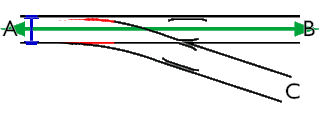
A junction, in the context of rail transport, is a place at which two or more rail routes converge or diverge. This implies a physical connection between the tracks of the two routes, provided by points and signalling. Junctions are important for rail systems, their installation into a rail system can expand route capacity, and have a powerful impact upon on-time performance.

In civil engineering, grade separation is a method of aligning a junction of two or more surface transport axes at different heights (grades) so that they will not disrupt the traffic flow on other transit routes when they cross each other. The composition of such transport axes does not have to be uniform; it can consist of a mixture of roads, footpaths, railways, canals, or airport runways. Bridges, tunnels, or a combination of both can be built at a junction to achieve the needed grade separation.

A double-track railway usually involves running one track in each direction, compared to a single-track railway where trains in both directions share the same track.

The B branch, also called the Commonwealth Avenue branch or Boston College branch, is a branch of the MBTA Green Line light rail system which operates on Commonwealth Avenue west of downtown Boston, Massachusetts. One of four branches of the Green Line, the B branch runs from Boston College station down the median of Commonwealth Avenue to Blandford Street. There, it enters Blandford Street portal into Kenmore station, where it merges with the C and D branches. The combined services run into the Boylston Street subway and Tremont Street subway to downtown Boston. B branch service has terminated at Government Center since October 2021. Unlike the other branches, the B branch runs solely through the city limits of Boston. The Green Line Rivalry between Boston College and Boston University is named in reference to the B branch, which runs to both universities.
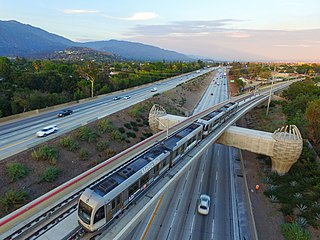
The A Line is a 48.5-mile (78.1 km) light rail line in Los Angeles County, California. It is one of the six lines of the Los Angeles Metro Rail system, operated by the Los Angeles County Metropolitan Transportation Authority (Metro). The A Line serves 44 stations and runs east-west between Azusa and Pasadena, then north-south between Pasadena and Long Beach. It interlines and shares five stations with the E Line in Downtown Los Angeles. Service operates for approximately 19 hours with headways of up to 8 minutes during peak hours. The A Line is currently the longest light rail line in the world.
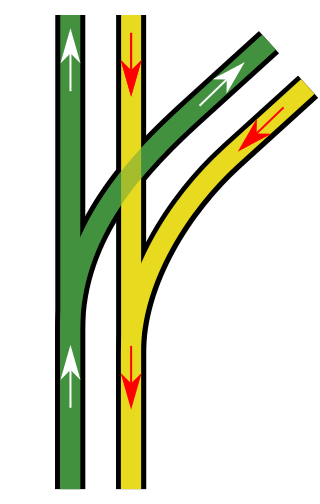
A level junction is a railway junction that has a track configuration in which merging or crossing railroad lines provide track connections with each other that require trains to cross over in front of opposing traffic at grade.

The HSL 1 is a high-speed rail line which connects Brussels, Belgium, with the LGV Nord at the Belgium–France border. It is 88 km (55 mi) long with 71 km (44 mi) of dedicated high-speed tracks and 17 km (11 mi) of modernised lines. Service began on 14 December 1997.

The Brighton Park crossing is a major railroad crossing in Chicago, Illinois, hosting three major freight railroads. The crossing is northwest of the intersection of Western Avenue and Archer Avenue, in the Brighton Park neighborhood of Chicago, Illinois. The railroads involved in the crossing are CSX, Canadian National and Norfolk Southern. The crossing consists of the CN's two-track Joliet Subdivision in a roughly east–west orientation intersecting five north–south tracks operated by NS and CSX. Collectively, these railroads operate approximately 80 trains per day through the crossing. The junction is visible from the CTA Orange Line trains that pass on an elevated structure immediately southeast of the crossing.
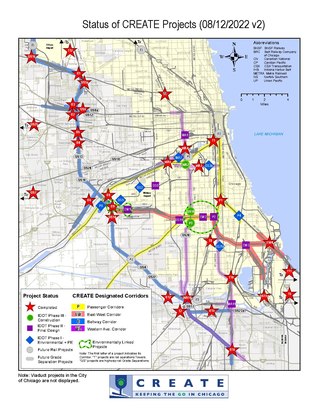
The Chicago Region Environmental and Transportation Efficiency (CREATE) Program is a $4.6 billion program to improve the efficiency and effectiveness of freight, commuter and intercity passenger rail and to reduce highway delay in the Chicago region. The Program consists of 70 projects, which includes constructing grade separations, flyovers and other rail projects to ease both rail and roadway congestion. The status of each of the 70 projects varies, with many having been completed, others in design or construction and some not yet started. Costs for the projects are covered by public and private funding from the Program's partners: the United States Department of Transportation, the Illinois Department of Transportation, Cook County, the City of Chicago, and public and private railroads.

A quadruple-track railway is a railway line consisting of four parallel tracks with two tracks used in each direction. Quadruple-track railways can handle large amounts of traffic, and so are used on very busy routes or sections. Such conversion is referred to as "quadruplication".

France has a large network of high-speed rail lines. As of June 2021, the French high-speed rail network comprises 2,800 km (1,740 mi) of tracks, making it one of the largest in Europe and the world. As of early 2023, new lines are being constructed or planned. The first French high-speed railway, the LGV Sud-Est, linking the suburbs of Paris and Lyon, opened in 1981 and was at that time the only high-speed rail line in Europe.

Zoo Junction is a junction on Amtrak's Northeast Corridor in Philadelphia, Pennsylvania, where the Northeast Corridor meets the Keystone Corridor, previously known as the Pennsylvania Railroad's main line.
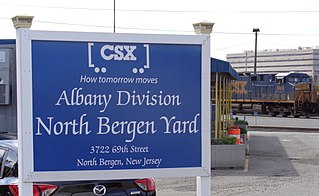
The North Bergen Yard is freight rail yard and intermodal terminal in North Bergen, New Jersey parallel to Tonnelle Avenue between 49th and 69th Streets. Located within the North Jersey Shared Assets Area, the facility is part of CSX Transportation (CSXT) and the origination point of its CSX River Subdivision at the southern end of the Albany Division. On its west side, the New York, Susquehanna and Western Railway (NYSW) runs the length of the yard and operates a bulk transloading operation immediately adjacent to it.
